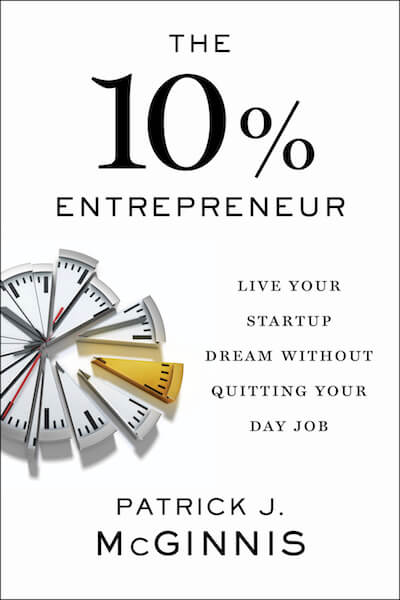Patrick McGinnis worked for the financial services giant AIG when the financial crisis hit in 2008. The aftermath of convinced him that he should take another look at investing in startups. In his book The 10% Entrepreneur, he talks about how he prospered devoting just a fraction of his time and money.
For the first decade of my career I viewed entrepreneurship as something for other people, but not for me. I was someone who exclusively sought the well-traveled path, worked for large corporations, and saw myself solidly fitting the mold of a ”company man.” That was enough. I expended too much energy working at one firm to consider adding to my workload. When I talked to friends who were taking part in new ventures outside of work, I smiled, thinking, “Why on earth would you want to spend your free time working?”
The financial crisis changed everything. As I struggled to plot my next steps, I decided that I needed to create a new type of career that would be achievable as well as sustainable. What would be the point of making changes that would be too difficult or too radical to actually put into practice? If I was going to go back to the drawing board, I needed to be realistic. Rather than becoming an entrepreneur, perhaps I could find a way to work entrepreneurship into my career without abandoning the concept of a day job. Maybe I‘d had it backward all along. Instead of thinking of entrepreneurship as something that was inherently risky, it could actually be my insurance policy.

In the very early days, when I was first starting to think about this incremental, more pragmatic approach to entrepreneurship, I talked to friends and even acquaintances about my idea. Pretty soon, I sat next to a guy on a plane who had invested some cash in a toy company. Then I heard that a friend was spending weekends working on a new fashion brand both as an investor and in exchange for free stock. I also learned that a former colleague was leveraging her credibility in the tech scene to advise startups all over the world. These were some of the first 10% Entrepreneurs I met, and although I didn‘t quite know how to describe what they were doing, one thing was clear: all of these people were onto something. As I grew convinced that I wanted to somehow become a 10% Entrepreneur, I was also consumed with doubt. I found myself grappling with a growing list of questions. How should I begin? How would I know what to do? Did I have sufficient time and money to dedicate to making it happen? How risky was it going to be? Did I have the judgment and the experience to make good decisions?
Now, five years later, having answered these questions for myself, I firmly believe that 10% Entrepreneurs are not born, they‘re made, and you can learn, just as I did. I have built a portfolio of professional activities that reflects my skills, interests, and relationships. All told, I have invested a combination of time and money in twelve entrepreneurial ventures. In seven of these instances, my ownership stake is either partly or entirely the result of an investment of time, which is commonly known as sweat equity, rather than money.
I have just one regret: Why didn‘t I start before? If I‘d woken up the day after the implosion of AIG with a portfolio of investments to provide me with safe passage until my life and my career stabilized, the entire experience would have been far less fraught and painful. Rather than mourning what I lost, I would have been able to direct my energies into something positive—my 10%.
Pursuing entrepreneurship on the side is a choice that is pragmatic rather than theoretical, so it‘s not just a cool idea that you‘ll never actually pull off in real life. You also don‘t need twenty years of experience, millions in the bank, or to be living in New York City or San Francisco or London. You just need confidence in your own abilities, a willingness to look for help when necessary, and the tools to get started.
Excerpted from THE 10% ENTREPRENEUR: Live Your Startup Dream Without Quitting Your Day Job by Patrick J. McGinnis with permission of Portfolio, an imprint of Penguin Publishing Group, a division of Penguin Random House LLC. Copyright (c) Patrick J. McGinnis, 2016.




